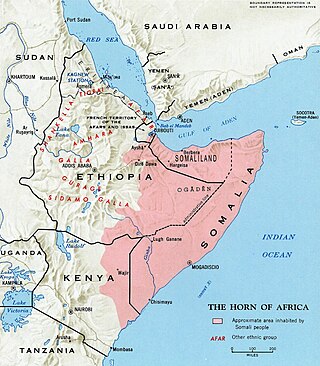Notes
- 1 2 3 Jiiddu at Ethnologue (27th ed., 2024)

- ↑ Ibro, Salim (1998). English - Jiddu – Somali Mini-dictionary (PDF). Victoria, Australia: La Trobe University Language Center.
| Jiiddu | |
|---|---|
| Af-Jiiddu | |
| Native to | Somalia |
| Region | Lower Shabelle, Bay, Middle Juba |
| Ethnicity | Somali (Jiiddu) |
Native speakers | 34,000 (2020) [1] |
| Language codes | |
| ISO 639-3 | jii |
| Glottolog | jiid1238 |
Jiiddu (also known as Jiddu or Af-Jiiddu) is a Somali language spoken by the Jiiddu sub-clan of the Dir, a Somali clan inhabiting southern Somalia. It currently has an estimated 34,000 speakers, concentrated in the Lower Shabeelle, Bay and Middle Juba regions. [1]
Typically classified as part of the Digil group of languages, Jiiddu has a different phonology and sentence structure from Somali. However, it more closely resembles Somali than Baiso. "It reportedly some similarities to Konsoid languages and to" and Highland East Cushitic languages spoken in southern Ethiopia. [1]
There is a dictionary of Jiddu by a native speaker, Dr. Salim Ibro. [2]

The Cushitic languages are a branch of the Afroasiatic language family. They are spoken primarily in the Horn of Africa, with minorities speaking Cushitic languages to the north in Egypt and Sudan, and to the south in Kenya and Tanzania. As of 2012, the Cushitic languages with over one million speakers were Oromo, Somali, Beja, Afar, Hadiyya, Kambaata, and Sidama.

Somali is an Afroasiatic language belonging to the Cushitic branch. It is spoken primarily in Greater Somalia, and by the Somali diaspora as a mother tongue. Somali is an official language in both Somalia and Ethiopia, and serves as a national language in Djibouti, it is also a recognised minority language in Kenya. The Somali language is officially written with the Latin alphabet although the Arabic script and several Somali scripts like Osmanya, Kaddare and the Borama script are informally used.

The Ajuran is a Somali clan, part of the Jambelle clan which itself belongs to the largest Somali clan-family — the Hawiye. Ajuran members largely inhabit Kenya as well as southern east Ethiopia; considerable numbers are also found in southern Somalia. Some Ajuran members are settled in Mogadishu.
Lowland East Cushitic is a group of roughly two dozen diverse languages of the Cushitic branch of the Afro-Asiatic family. Its largest representatives are Oromo and Somali.

The Garre are a prominent Somali clan that traces its lineage back to Samaale, who is believed to have originated from the Arabian Peninsula through Aqiil Abu Talib. The Garre clan is considered to be a sub-clan of the Digil-Rahanweyn clan family, which is part of the larger Rahanweyn clan. However, genealogically, they are descended from Gardheere Samaale. The Garre are also categorized as southern Hawiye as well.

Barawa, also known as Barawe and Brava, is the capital of the South West State of Somalia. It functions as a port town in the southwestern Lower Shebelle region of Somalia. Facing the Indian Ocean, Barawa serves as the main port of the South West State.

Bontoc (Bontok) is the native language of the indigenous Bontoc people of the Mountain Province, in the northern part of the Philippines.

The languages of Ethiopia include the official languages of Ethiopia, its national and regional languages, and a large number of minority languages, as well as foreign languages.

The Rahanweyn, also known as the Digil and Mirifle is a major Somali clan. It is one of the major Somali clans in the Horn of Africa, with a large territory in the densely populated fertile valleys of the Jubba and Shebelle rivers and the areas inbetween, which are mainly inhabited by settlers from the Digil and Mirifle lineages.

The endoglossic language of Somalia has always been Somali, although throughout Somalia's history various exoglossic languages have also been used at a national level.

Mai-Mai, commonly spelled Maay Maay, is a dialect of the Somali language of the Cushitic branch of the Afro-Asiatic family. It is mainly spoken in Somalia and adjacent parts of Ethiopia and Kenya. In Somalia, it is spoken in South West state, Jubaland state, and Banadir. It is one of the dialects of the Somali language.
Bravanese, also called Chimwiini or Chimbalazi, is a Bantu language related to Swahili spoken by the Bravanese people, who are the predominant inhabitants of Barawa, or Brava, in Somalia. Maho (2009) considers it a distinct dialect, and it has been classified as a Northern Dialect of Swahili. However, it strongly distinguishes itself from standard Swahili under all linguistic considerations.
North Mofu is an Afro-Asiatic language spoken in northern Cameroon. Dialects are Douroun and Wazan.
The Somali languages form a group that are part of the Afro-Asiatic language family. They are spoken as a mother tongue by ethnic Somalis in Horn of Africa and the Somali diaspora. Even with linguistic differences, Somalis collectively view themselves as speaking dialects of a common language.
Dabarre is a Somali language spoken by the Dabarre and Ciroole, both sub-clans of the Digil clan family of Somalis inhabiting southwestern Somalia. It has an estimated 34,000 speakers. Dialects include Dabarre and Iroole (Af-Iroole).
Garre is a Somali language spoken by the Garre who reside in southern Somalia, Ethiopia and northern Kenya. It belongs to the family's Cushitic branch, and had an estimated 50,000 speakers in Somalia in 1992, 57,500 in 2006 and 86,000 in 2020. The total number of speakers in Kenya and Somalia was estimated at 685,600 in 2019. Garre is in the Digil classification of Somali dialects. Garre language is readily intelligible to Digil speakers, as it has some affinity with Af-Maay and Af-Boon.
Northern Somali, , is a dialect of the Somali language and forms the basis for Standard Somali. It is spoken by more than 70% of the entire Somali population, with its speech area stretching from Djibouti, Somaliland and the Somali Region of Ethiopia to the Northern Frontier District in Kenya. This widespread modern distribution is a result of a long series of southward population movements over the past ten centuries from the Gulf of Aden littoral.
Ashraf is a speech variety of Somali spoken in the Marka district of the Lower Shebelle region and Banaadir region of southern Somalia.
The Tunni are a Somali clan that make up part of the wider Digil-Rahanweyn branch. It is one of the major clans that inhabit the South West State of Somalia and can also be found in Jubbaland.
The Tunni Sultanate was a Somali Muslim Sultanate located in southwestern Somalia, south of the Shabelle river. It was ruled by the Tunni people, who spoke the Af-Tunni. The historical Tunni area corresponds to the modern-day Lower Shabelle region.